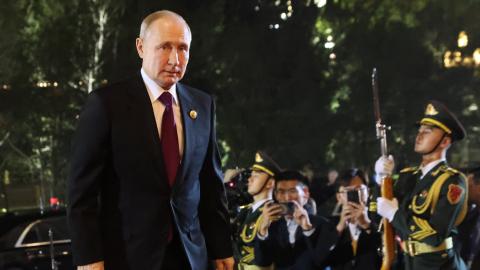"You must look at facts, because they look at you,” Winston Churchill once observed. One unpleasant fact that the war in Ukraine has thrown into sharp relief is that a global axis of anti-American powers is forming to undermine the U.S.-led international order. America’s adversaries are aligning their moves on the global chessboard and undertaking a process of strategic convergence.
When Russian President Vladimir Putin launched his full-scale invasion of Ukraine nearly two years ago, he sensed in the White House a weak and ineffectual opponent. Like fine wine gone to vinegar, U.S. President Joe Biden’s outreach to Putin culminated in the full-scale invasion of Ukraine — with Putin calculating that the Biden White House would simply swallow a bitter fait accompli as the Obama administration did with Putin’s seizure of Crimea. But Putin did not reckon with the tenacity of the Ukrainians. Against heavy odds, Ukraine repelled Russia’s initial attacks and remains in the fight to this day. Putin took aim at Biden’s glass jaw and struck Ukrainian steel instead.
Those losses have forced Putin to upgrade relations with three key allies: Iran, North Korea, and China. Last year, Iran began to supply Moscow with large numbers of Shahed kamikaze drones at a moment when Russia needed an affordable long-range strike weapon, culminating in last month’s biggest drone attack on Kyiv since the start of the war. Now, Russia and Iran are collaborating on a new drone production facility east of Moscow which will be able to produce thousands of drones each year. Worse, Iran is reportedly considering supplying Russia with ballistic missiles — a transfer made easier by the expiration of the missile embargo under the terms of the Iran nuclear deal (JCPOA).
As the West scrambles to find adequate air defenses, Russia is pummeling Ukraine with weapons made in Iran and normalized under the JCPOA. The upshot is the start of a long and grueling winter for Ukraine.
In September, Putin welcomed North Korea’s Kim Jong Un for talks at the Vostochny Cosmodrome in Russia’s Far East. Pyongyang responded to the invitation by supplying Moscow with more than one million artillery shells, reportedly according to South Korean intelligence. Meanwhile, German Defense Minister Boris Pistorius recently conceded that the European Union will not meet its target of supplying Ukraine with one million shells and missiles by March 2024. In an artillery-heavy war, Russia is rebuilding its stockpiles while Ukraine is suffering from shell hunger.
And Russia’s alliances are not a one-way street. As John Kirby, the White House spokesman, said last year, Russia is offering Iran “an unprecedented level of military and technical support that is transforming their relationship into a full-fledged defense partnership.” Iranian sources are now boasting that Tehran may soon receive Sukhoi Su-35 fighter jets and Mil Mi-28 attack helicopters from Russia. Moreover, after U.S. officials warned last month that the Russian Wagner Group may provide the SA-22 air-defense system to Lebanese Hezbollah, U.S. and Israeli officials face the grim possibility of Russia transferring its advanced S-400 air-defense system to Iran as well.
The story for North Korea is much the same. At their September meeting, Putin pledged to help Kim overhaul his space program. Just two months later, North Korea overcame past failures to successfully send a reconnaissance satellite into orbit. Kim also took the time while in Russia to tour a Russian aircraft factory and review the Russian fleet at Vladivostok. It may be that significant military transfers from Russia to North Korea are in the offing, with dire consequences for the security of northeast Asia.
Of course, Russia’s most important partnership is with the People’s Republic of China (PRC). The PRC has helped Russia beat U.S. controls on semiconductors, access military and dual-use technologies, and circumvent the U.S. dollar in bilateral trade. Most of all, the PRC has helped replace the decline in Russian energy exports to Europe, leading to a record $190 billion in Sino-Russian trade in 2022. PRC leader Xi Jinping knows well that the collapse of the European order would bring the dawn of a Sino-centric age that much closer. As he told Putin in Moscow last March, “Right now there are changes, the likes of which we haven’t seen for 100 years, and we are the ones driving these changes together.”
Whatever merit President Biden saw in appeasing Russia and Iran early in his presidency to focus on China has proven to be a dangerous illusion. The U.S. must now strengthen its own network of partners in response. Thankfully, we have partners in these key regions who are willing to shoulder the burden of front-line defense.
In 20 months of combat, Ukraine has inflicted on Russia an estimated 300,000 casualties, and has destroyed thousands of heavy armor and hundreds of fixed- and rotary-wing aircraft. Its attacks on the headquarters of Russia’s Black Sea Fleet and strikes on submarines and surface combatants, including the sinking of the Moskva, have forced the Kremlin to relocate major naval assets from Sevastopol to Novorossiysk.
In the Middle East, Israel is at war destroying Iran’s major proxies in Hamas and Palestinian Islamic Jihad. In Lebanon and Syria, Israel has also targeted the operations of Hezbollah, Iran’s most powerful and important proxy.
Rather than restrain Ukraine or Israel, the U.S. should empower them to win their respective conflicts now to avoid an even broader and costlier fight later.
From security assistance to diplomatic support and economic sanctions, the Biden team should intensify its support for Kyiv and Jerusalem and turn the screws on Tehran and Moscow
The Biden administration’s attempts to appease Russia and Iran ended with war in both Europe and the Middle East. In this light, its recent courtship of the PRC should be cause for concern. A major war with the PRC in the Western Pacific would be the costliest conflict of all. A strong American posture in Asia that backs Taiwan fully and supports major allies like South Korea and Japan is the best way to preserve the peace.
That the world is now a much more chaotic place than it was at President Biden’s inauguration is a fact that is impossible to ignore. It’s time to get back to foreign policy basics before the chaos spreads even more.





















